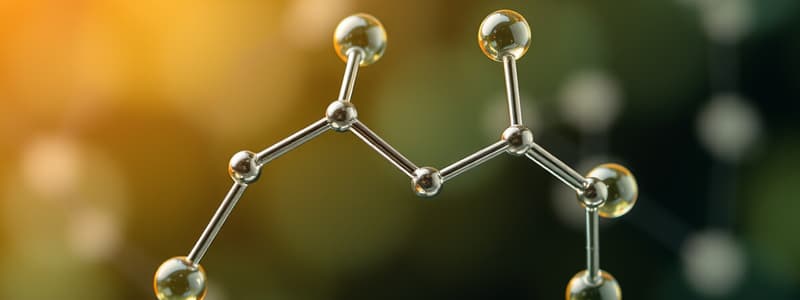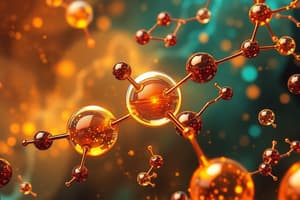Podcast
Questions and Answers
What is organic chemistry?
What is organic chemistry?
- The study of all chemical reactions
- The study of environments and ecosystems
- The study of carbon compounds (correct)
- The study of inorganic compounds
What is a hydrocarbon?
What is a hydrocarbon?
An organic molecule composed of only carbon and hydrogen atoms.
What is an isomer?
What is an isomer?
Compounds with the same chemical formula but different structures.
What is a structural isomer?
What is a structural isomer?
What is a geometric isomer?
What is a geometric isomer?
What is an enantiomer?
What is an enantiomer?
What is a functional group?
What is a functional group?
What does the hydroxyl group represent?
What does the hydroxyl group represent?
What is the carbonyl group represented as?
What is the carbonyl group represented as?
What is an aldehyde?
What is an aldehyde?
What is a ketone?
What is a ketone?
What is a carboxyl group?
What is a carboxyl group?
What does the amino group signify?
What does the amino group signify?
What represents a sulfhydryl group?
What represents a sulfhydryl group?
What is a phosphate group?
What is a phosphate group?
What is a polymer?
What is a polymer?
What is a monomer?
What is a monomer?
What is dehydration synthesis?
What is dehydration synthesis?
What is hydrolysis?
What is hydrolysis?
What are carbohydrates?
What are carbohydrates?
What is a monosaccharide?
What is a monosaccharide?
What is a disaccharide?
What is a disaccharide?
What is a polysaccharide?
What is a polysaccharide?
What is a glycosidic linkage?
What is a glycosidic linkage?
What is starch?
What is starch?
What is glycogen?
What is glycogen?
What is cellulose?
What is cellulose?
What is chitin?
What is chitin?
What is a lipid?
What is a lipid?
What is fat?
What is fat?
What is saturated fat?
What is saturated fat?
What is unsaturated fat?
What is unsaturated fat?
What is a steroid?
What is a steroid?
What is cholesterol?
What is cholesterol?
What is a protein?
What is a protein?
What is a polypeptide?
What is a polypeptide?
What is an amino acid?
What is an amino acid?
What is a peptide?
What is a peptide?
Flashcards are hidden until you start studying
Study Notes
Organic Chemistry
- Study of carbon compounds, fundamental to understanding biological processes and compounds.
Hydrocarbons
- Organic molecules consisting solely of carbon and hydrogen atoms, foundational for many organic compounds.
Isomers
- Compounds with identical chemical formulas but differing structural configurations, leading to different properties.
Structural Isomers
- Variants that have the same molecular formula but differ in the arrangement of covalent bonds among atoms.
Geometric Isomers
- Compounds with the same formula but distinct spatial arrangements of substituents around a double bond, impacting their chemical reactivity.
Enantiomers
- Pair of molecules that are mirror images of each other, significant in pharmaceuticals due to differing biological effects.
Functional Groups
- Specific clusters of atoms within molecules that dictate how those molecules interact with other compounds.
Hydroxyl Group
- Denoted as -OH; characteristic of alcohols (e.g., ethanol), polar in nature, and contributes to hydrophilicity.
Carbonyl Group
- Functional group represented as -CO; found in key biological molecules including sugars and fats.
Aldehyde
- Organic compound where the carbonyl group is positioned at the end of the carbon chain.
Ketone
- Compound featuring a carbonyl group situated within the carbon skeleton, typically more stable than aldehydes.
Carboxyl Group
- Represented as -COOH; combines hydroxyl and carbonyl, exhibiting acidic properties.
Amino Group
- Identified as -NH2; plays a crucial role in the formation of amino acids and acts as a base.
Sulfhydryl Group
- Noted as -SH; important in protein structure and function through the formation of disulfide bonds.
Phosphate Group
- Denoted as -PO4; essential for energy transfer in cells and structural components of DNA and RNA.
Polymers and Monomers
- Polymers are large compounds made from numerous monomers, which are simple units capable of bonding to form larger structures.
Dehydration Synthesis
- A reaction involving the covalent bonding of two molecules accompanied by the removal of a water molecule, crucial for polymer formation.
Hydrolysis
- Reaction that involves adding water to break down macromolecules, reversing dehydration synthesis.
Carbohydrates
- Includes starches and sugars, serving as primary energy sources in food.
Monosaccharides
- Basic sugar units, the simplest form of carbohydrates (e.g., glucose).
Disaccharides
- Sugars composed of two monosaccharides linked together (e.g., sucrose).
Polysaccharides
- Large polymers formed from many monosaccharides; examples include starch, glycogen, and cellulose.
Glycosidic Linkage
- A covalent bond that forms between two monosaccharides through a dehydration reaction.
Starch
- Energy storage polysaccharide found in plants, composed entirely of glucose units.
Glycogen
- Highly branched polysaccharide for glucose storage in animal tissues, mainly found in liver and muscles.
Cellulose
- Structural polysaccharide made of glucose, forms cable-like fibers providing rigidity in plant cell walls.
Chitin
- A complex carbohydrate that forms the cell walls of fungi and is found in the exoskeletons of arthropods.
Lipids
- Diverse group of macromolecules primarily made of carbon and hydrogen; includes fats, oils, and waxes.
Fats
- Organic compounds with a structure of glycerol attached to three fatty acids, important for energy storage.
Saturated Fats
- Lipids with fatty acids containing no double bonds, typically solid at room temperature, commonly found in animal products.
Unsaturated Fats
- Lipids containing at least one double bond in fatty acids, usually liquid at room temperature, primarily found in plant oils.
Steroids
- A class of lipids composed of four carbon rings, serving various biological roles including hormone function.
Cholesterol
- A key steroid in animal cell membranes, acts as a precursor for other important steroids and hormones.
Proteins
- Macromolecules consisting of carbon, hydrogen, oxygen, and nitrogen, essential for growth, repair, and enzymatic functions.
Polypeptides
- Chains of amino acids linked by peptide bonds, which fold into functional proteins.
Amino Acids
- Organic compounds with an amino group, a carboxylic acid group, and various side chains; 20 standard amino acids exist.
Peptide Bonds
- Bonds formed between amino acids through a dehydration reaction, creating polypeptides and proteins.
Studying That Suits You
Use AI to generate personalized quizzes and flashcards to suit your learning preferences.




